 A curious set of circumstances will see me spending the next week in Calgary wearing two overlapping hats – Hacker in Residence and Reinvented – to engage in a rollicking good time amongst academics working in information visualization and surface computing, with an eye to developing collaborations around a number of projects, including the energy thingy that Scott Bateman has been developing for Reinvented, the Social Consumption Project that I’ve been funded by the City of Charlottetown to carry out, the Archiving Geopresence project that I’ve been working on for several years, and a variety of other projects and pipe dreams (including an idea that’s been floating around my head to someone illuminate the Samuel Holland township lot lines so that they can be seen from outer space: I’m pretty sure there’s a better approach than my “light a lot of bonfires” idea).
A curious set of circumstances will see me spending the next week in Calgary wearing two overlapping hats – Hacker in Residence and Reinvented – to engage in a rollicking good time amongst academics working in information visualization and surface computing, with an eye to developing collaborations around a number of projects, including the energy thingy that Scott Bateman has been developing for Reinvented, the Social Consumption Project that I’ve been funded by the City of Charlottetown to carry out, the Archiving Geopresence project that I’ve been working on for several years, and a variety of other projects and pipe dreams (including an idea that’s been floating around my head to someone illuminate the Samuel Holland township lot lines so that they can be seen from outer space: I’m pretty sure there’s a better approach than my “light a lot of bonfires” idea).
Two hats requires two business cards, so I’ve got the case packed with half of each. And which had I’m wearing at any given time – adventurous hacker or keen capitalist – will depend on the circumstance and my mood.
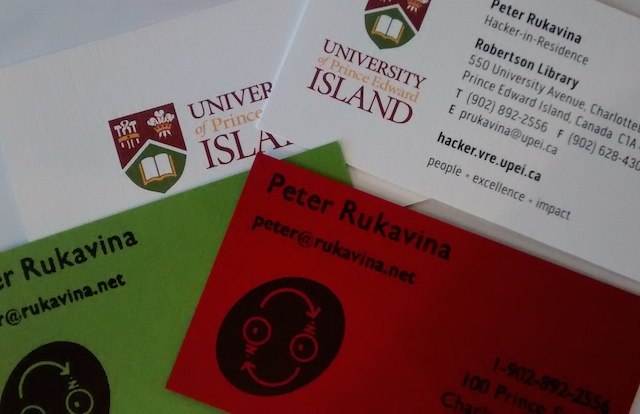
I’m taking the long way to get to Calgary, stopping in Toronto tonight, flying to Vancouver tomorrow and then immediately on to Calgary, and then, next Friday, flying back to Vancouver for a quick two-day stopover before arriving back in Charlottetown a week from Sunday.
Or at least that’s the plan: Air Canada has been sending me flight notifications all afternoon long moving the departure time for my flight to Toronto ahead. Projecting forward, at this rate I’ll likely be leaving after I come home.
A couple of days ago I received an email from AVIS car rental that pointed me to a website where they informed me that they had billed me $23.00 for passing through a Massachusetts Turnpike toll plaza on July 16, 2014:

I was, in fact, in New England that week, on business with Yankee Publishing, and I did rent a car from AVIS, so that much is true.
But I wasn’t in Massachusetts on July 16, and I know this because, since May, I’ve been archiving my “personal geolocation” to my own server, and looking at where I was at on July 16 you can see that my travels were limited to a triangle of Peterborough, NH (where my hotel was), Dublin, NH (where Yankee is) and Hancock, NH (where I had supper with my colleagues on the Yankee web team):
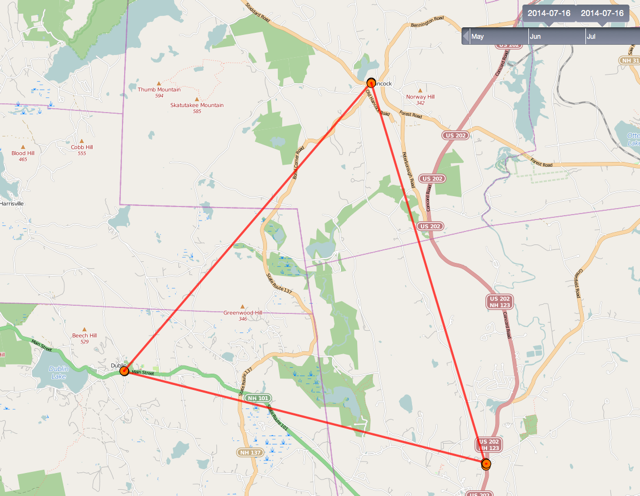
If my own geoarchiving wasn’t enough. Google is keeping track of me too (and with even more resolution), and Google Location History clearing shows me in Peterborough, NH at midnight, which would make it impossible for me to be in Massachusetts 9 minutes later:
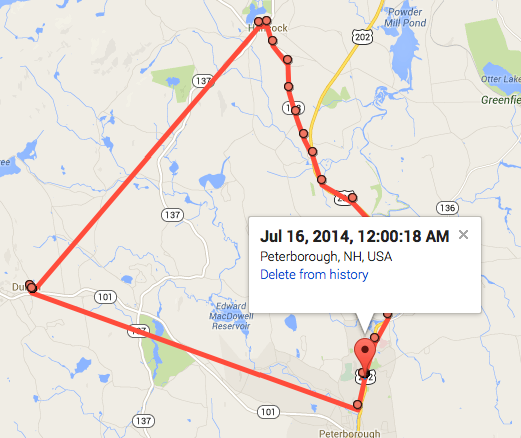
None of this would likely hold up in a law court, but it was enough for me to be able to report to AVIS with confidence that the charge was spurious. So I called AVIS, and explained the situation. They told me that their records indicate that the charge was based on a photograph of a license plate, and that it was likely a mis-read, especially because the toll receipt shows me exiting the turnpike, but not entering it.
Not since the great Plazes geolocation event of summer 2005, which introduced me to Ton and Martin has having a device in my pocket keeping track of where I am been so much fun.
Remember Robert P. Haythorne, the most interesting Prince Edward Island premier you’ve never heard of? Well a bunch of modern-day Islanders from Haythorne’s stomping grounds in Marshfield are seeking to rectify this under the banner of PEI2014.
On Saturday, October 4 (rain date is Sunday), starting with a 4km walk on “Senator Haythorne Lane” at 1:15 p.m. and continuing with formal festivities at 2:00 p.m., the memory of Haythorne will be feted in the style he richly deserves:
- A talk by Jim Hornby, “Poore by Name – Rich by Nature.”
- Signing of a petition to name the trail right-of-way in honour of Haythorne.
- Musical entertainment and refreshments.
It’s all hosted by the Hillsborough River Association, the Marshfield Pioneer Cemetery Trust Fund and the Marshfield WI.
Remember the Confederation Country Cabinet project that I made a small contribution to this spring?
Well I was delighted to receive a copy of the book that Brenda Whiteway arranged to have produced by the talented Judy Gaudet that details the genesis and execution of the cabinet. As someone whose head was deep inside the project for many months, the greatest role the book plays is allowing me insight to the other artists who were busy making their contributions at the same time.
Like Joe McAskill, the woodworker who brought the cabinet itself to life:
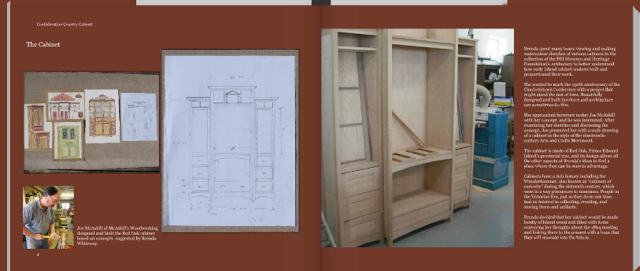
And Brenda herself, who not only spun flax into linen, but who actually grew the flax herself:
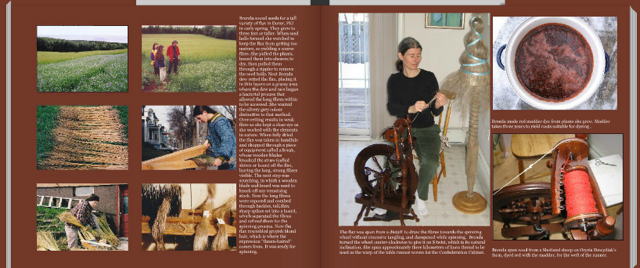
There’s a story about each of the potters who crafted drinking vessels – one per Father of Confederation – along with a photo of each:
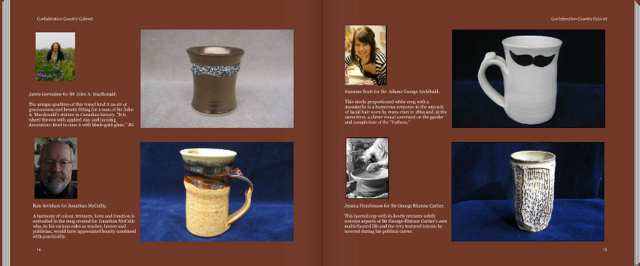
And an embarrassing number of photos of me at the printing press:
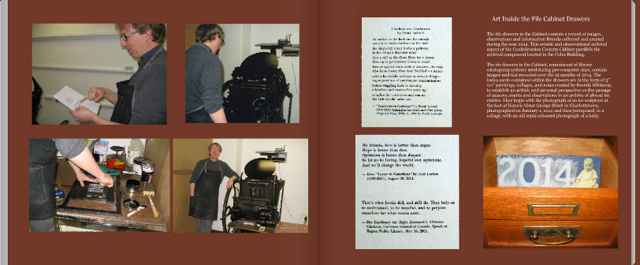
The book is available for purchase online and you can also preview the entire thing there in its full-colour 30 page glory. Because it’s a “print on demand” project, there are absolutely no economies of scale to the printing, so it’s not an inexpensive tract. But as a result you can order it in any of hardcover, hardcover with dust jacket or soft cover.
Here’s what page 3 of The Charlottetown Guardian looked like on May 3, 1922:
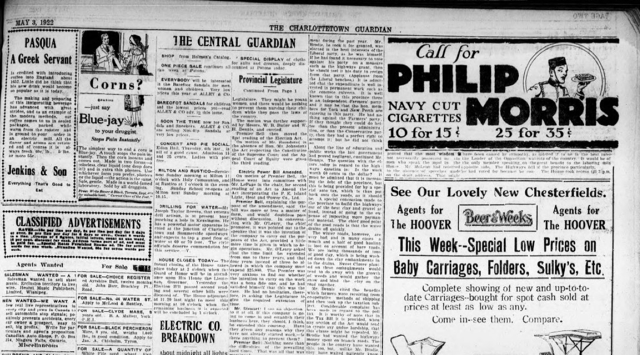
In amongst the ads for “barefoot sandals” and an 8-year old Clyde Mare and Navy Cut Cigarettes was the end of the report from the Provincial Legislature that started on page 1 under the headline “Lively Debate on Women’s Franchise Resolutions.”
Those resolutions involved the extension of the right to vote to women, the heart of which came in the preamble:
RESOLVED – That it is expedient to introduce a bill to extend the franchise to women; And that the qualification of male and female voter should be the same.
After some of that “lively debate,” much of which appears to have been taken up with procedural questions cloaking misgivings by men about women have the right to vote, the resolution passed:
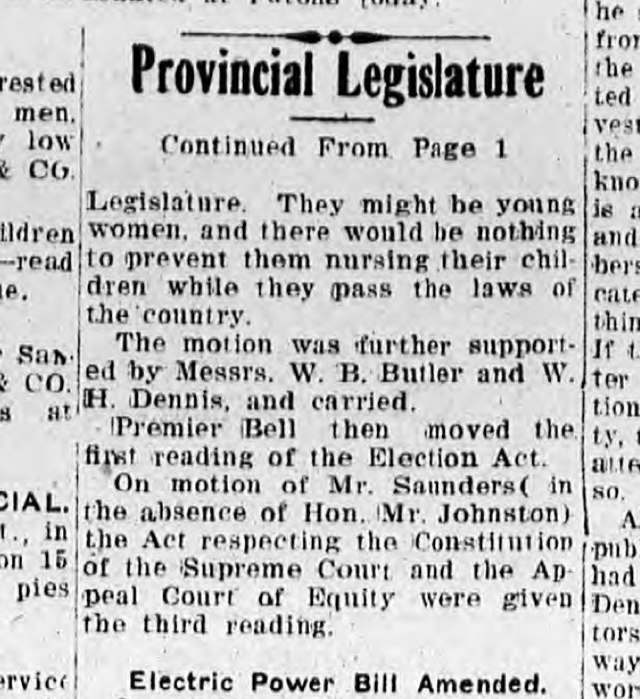
And that was it. There was no further mention of this dramatic change in that day’s paper, nor in the next day’s paper nor in the day after that. “The motion was further suppored by Messrs. W.B. Butler, and W.H. Dennis, and carried.” That was it.
If you visit WhatsMyLot.com and you happen to be on Prince Edward Island with a device – a desktop, a laptop, a mobile phone, a tablet – that knows its own location, the little app you find there will tell you which of the township lots originally set out by Samuel Holland in 1765 you happen to be standing in.
Here’s what it looks like when I call it up on my phone here in my office in Charlottetown:
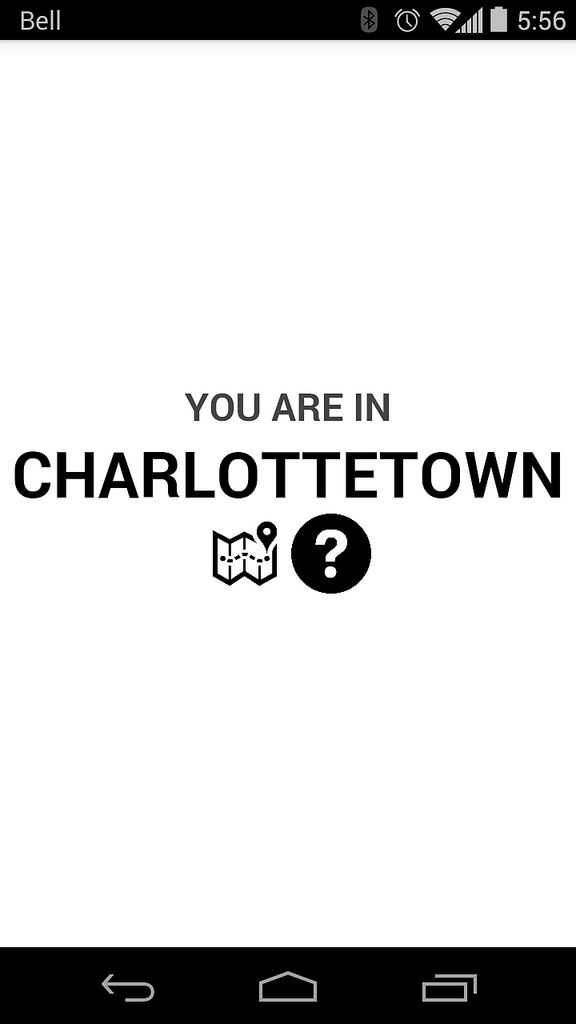
If I tap on the map icon, I see my township – Charlottetown Royalty, in this case – highlighted, and a marker showing my current location:
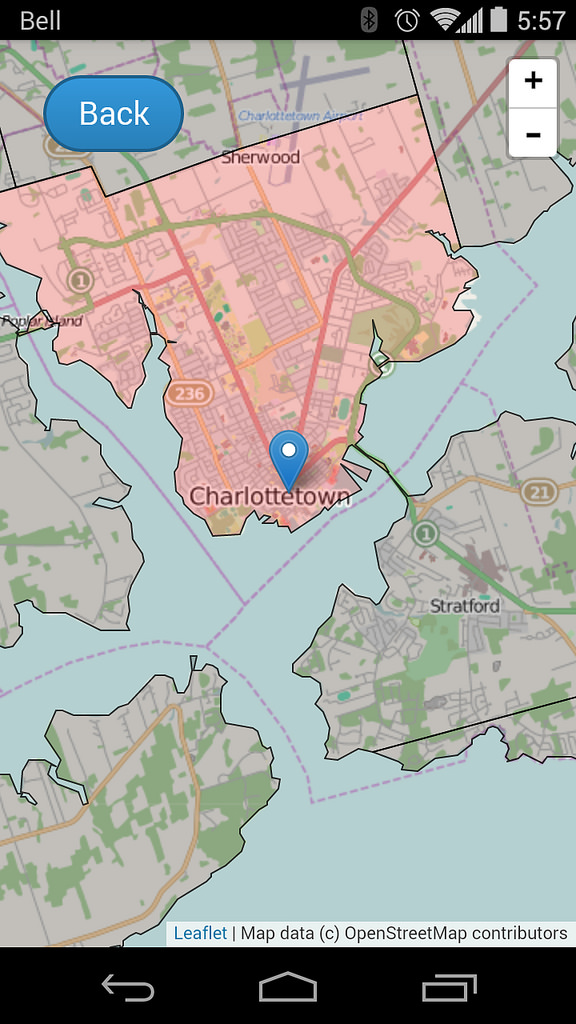
If you leave the app running on your device and go for a ride in the countryside, as you cross lot boundaries you’ll see the lot number update as you drive (once you’ve loaded the app, you don’t need to have Internet connectivity for it to work: all of the logic of finding your location and identifying your lot happens on the device, using JavaScript).
The app also remembers which lots you’ve visited, colouring the lots red as you visit them. Collect all 67 (plus 3 royalties), and you win the Island!
This is just an alpha release of the app, to receive feedback in advance of packaging it up for the various app stores in preparation for the 250th anniversary of Holland’s survey next year. So, please provide feedback.
Spotted at the Trinity-Clifton United Church manse fence yesterday around dusk.
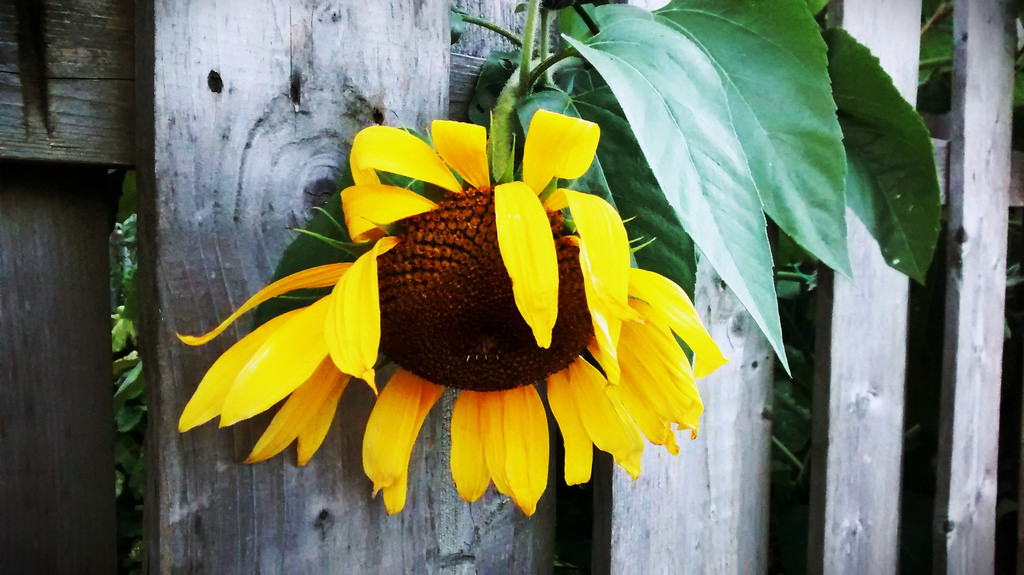
Download the ESRI Shapefile version of the lots from the PEI GIS Catalog and open the resulting lot_township_polygon.shp in QGIS.
In QGIS, right-click on the layer in the layer browser, and select:
- Format: ESRI Shapefile
- Save as (filename): pei-lots-wgs84.shp
- Encoding: System
- CRS: Selected CRS (then click Browse below, and select WGS 84)
Your “Save vector layer as…” dialog should look something like this:

Close and reopen QGIS and open the newly-created pei-lots-wgs84.shp file, which should look like this:

If you save this as a GEOJSON file at this point, because it’s a very-detailed map the size of the file will be multi-megabytes. We want to create a smaller file, by simplifying the geometer of the lots.
To do this, select Vector menu > Geometry tools > Simplify geometries in QGIS, enter a new file name, pei-lots-wgs84-simplified.shp, using the default tolerance of 0.0001 and click OK to process.
The result will be a new, simpified Shapefile that you can now export to a GeoJSON file; load the new, simplified layer, then right-click on the layer in the layer browser, and select:
- Format: GeoJSON
- Save as (filename): lots.geojson
- Encoding: System
- CRS: Layer CRS
You can load the resulting GeoJSON file into geojson.io – it’s about 1.9MB.
Here’s a snippet from The Guardian, September 14, 1914, showing the September 1914 tide predictions for Charlottetown and highlighting the high tide times for this day, 100 years ago:
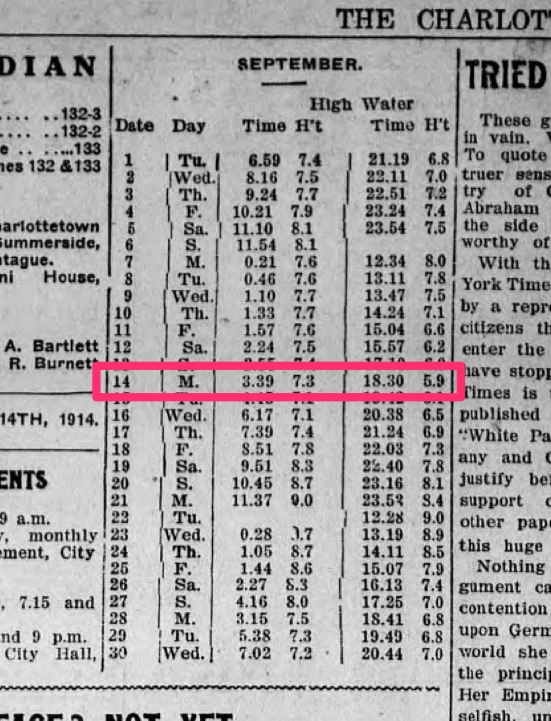
Here’s a snippet from The Old Farmer’s Almanac Tide Predictions Calculator showing the predicted tides for September 14, 1914:
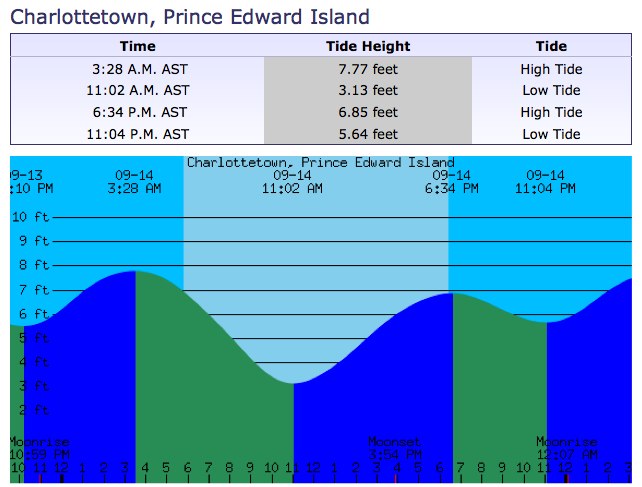
Comparing the two you can see that the high tide times predicted in The Guardian 1914 were 3:39 a.m. and 6:30 p.m.; the Almanac’s modern-day calculation puts these at 3:28 a.m. and 6:34 a.m., a different of 11 minutes and 4 minutes respectively. The Guardian predicted high tide height of 7.3 feet and 5.9 feet; the Almanac predicts 7.77 feet and 6.85 feet; not the same, but certainly in the same ballpark.
Although most every day of my working life for the past 18 years has, in one way or another, been steeped in the Moon and the Sun and the tides and the planets and the weather in one way or another, it never ceases to amaze me that the forces of nature have such a rhythm that they can be predicted not only a month in advance, but from a distance of 100 years.
A few days ago I spotted an intriguing photo on Instagram, taken by the inimitable Tristan Gray (who, among other things, might be PEI’s most attentive restaurant worker), of a new PEI Brewing Company – Receiver Coffee mashup, “Coffee Stout”:
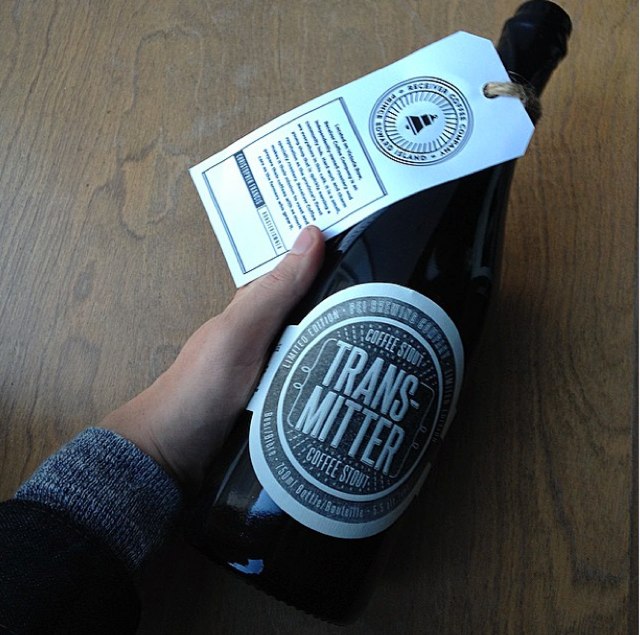
While I’m a regular consumer of Receiver’s coffee, I’m not a beer drinker, and so I haven’t paid much attention to the PEI Brewing Company, something not aided by its remote location in Charlottetown’s industrial suburbs.
But I liked the product design, and was curious about what the result of coffee + beer would be like, and so I decided to incorporate a visit to the company’s beer store on a cycle ride out to the University of PEI last night.
I turned to Google Maps for some guidance on the best cycle route and how long it would take to get out there, assuming that it might take 20 or 30 minutes to cycle so far out into the hinterland of the city. To my surprise, Google said 8 minutes:
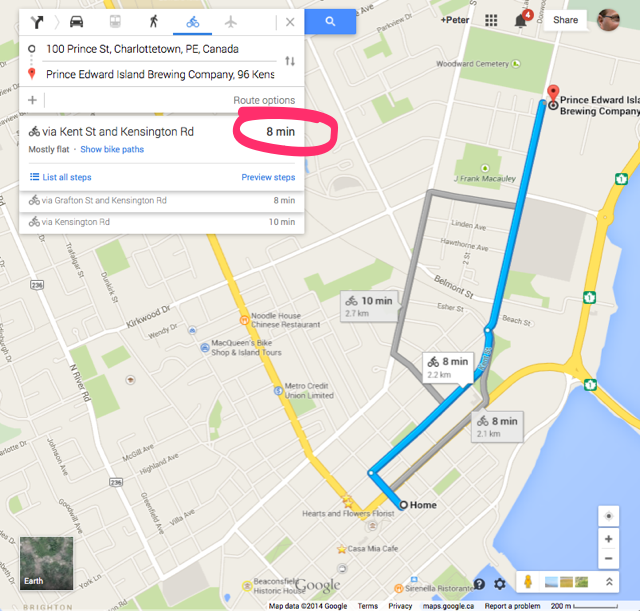
I balked: there’s no way it was only going to take 8 minutes to cycle that far. So I started the stopwatch on my phone as I headed out the door. And I stopped the stopwatch on arriving at the Brewing Company, Here’s what it looked like:
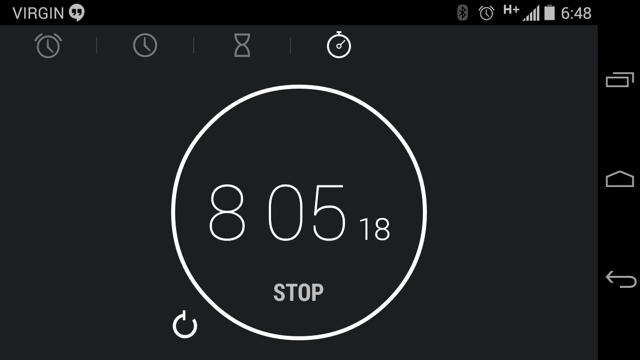
Eight minutes and five seconds. Amazing.
This simply serves to confirm the existence of the Charlottetown proximity-estimation-distortion-field when it comes to walking and cycling: we all grossly overestimate the time and distance between downtown and anything north of Euston Street. The notion, for example, of walking (Google says 51 minutes) or cycling (15 minutes) up to the Charlottetown Mall, would be considered by most here to be completely absurd, and akin to, say, walking to Moncton.
I bundled my beer into my bicycle basket and headed through the People’s Cemetery to St. Peters Road, then along Belvedere to the university, where I took in a lecture by Doug Sobey on the pre-settlement history of Prince Edward Island’s forests (it was fascinating, and incorporated the best use of PowerPoint I’ve ever seen).
When I emerged into the night at lecture’s end it was raining. Fortunately I was wearing my rain coast – the same German one that kept me partially dry during the Incident at Bukovel – and my bicycle was wearing its very-bright MEC lights, so I was able to almost-pleasantly cycle down the Confederation Trail to home. I arrived 15 minutes later a little soggy by happy in the new realization that everything is closer than I think.
 I am
I am